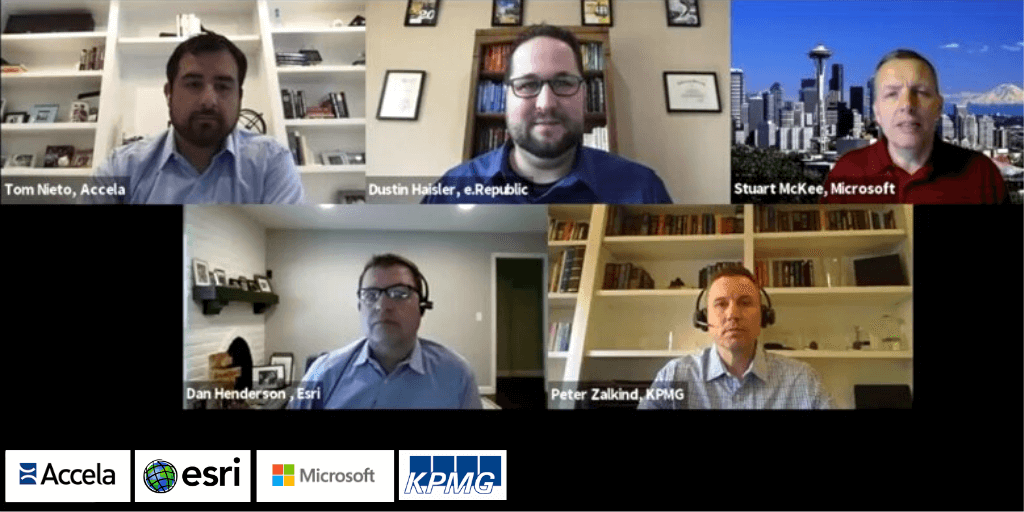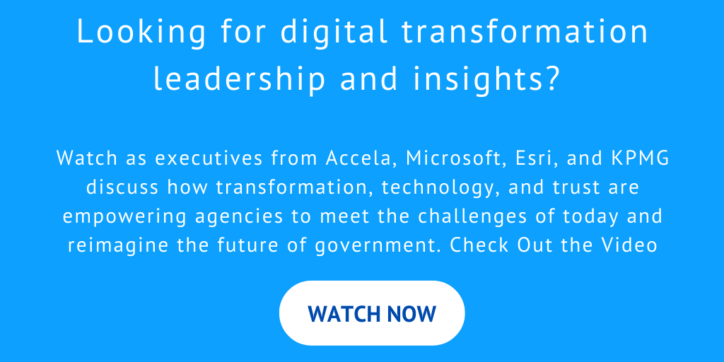At the recent Govern the Future Academy by Accela, we had the opportunity to participate in a roundtable panel discussion on digital transformation and innovation in government services with some of the leading voices in govtech. Our partners from Esri, KPMG and Microsoft joined Accela COO Tom Nieto and moderator Dustin Haisler for a wide-ranging discussion on transformation, technology, and trust as we work through the current pandemic and eventual reopening, and assess governments’ ability to respond and innovate. The discussion lasted 45 minutes and covered topics ranging from myths around digital transformation to the role of trust in government. For the sake of clarity and length, we are breaking the discussion transcript into two parts and will publish both parts this week.
In Part 1, the panel takes on some of the myths around digital transformation in government and how government agencies can prepare for a more successful transformation journey. In addition, we will provide some insights on leveraging online channels for more powerful collaborations between government agencies and partners. Finally, we’ll dive deep on the importance of trust between government agencies and constituents.
Stay tuned for part 2, when we’ll discuss how to make the most of the infrastructure and technology aspects of a reimagined government, as well as some of the unexpected benefits of rapid cloud deployment during the pandemic.
We hope you enjoy our panel’s industry insights and best practices, and encourage you to join the discussion by leaving your feedback or questions in the comment box following the article. Thanks again to our panel participants, who included:
- Dustin Haisler, CIO, e.Republic & Moderator
- Dan Henderson, Esri, Regional Sales Manager
- Stuart McKee, Microsoft CTO, State and Local Government
- Tom Nieto, Accela COO
- Peter Zalkind, KPMG Principal, State and Local Government
Myths around digital transformation for government
Dustin Haisler: Digital transformation has been a hot topic for a while, but as government agencies, we’ve really been pushed to modernize during the pandemic. What are the biggest myths around digital transformation?
Peter Zalkind: One of the biggest myths around digital transformation is that governments move slowly. What the pandemic has shown is that governments can actually move fast, and agency teams can move quickly when we let them do their jobs. It took an emergency decree in California to give governments the power and ability to move quickly, but they certainly did. We have projects that used to take years that are now literally being done in 15 days. And so, we’re doing enterprise deployments real quick. I think we have broken the myth that government is slow. It’s really about the rules of engagement, and how do we free up everybody to be agile and productive.
Stuart McKee: It’s been interesting to me the myth that the government can’t work from home or work remotely. Not only is government moving fast — and necessarily so — but people are working from home already, and rallying from all kinds of geographies and locations, which is super-impressive. It’s been challenging, it’s been hard, and I know it hasn’t been perfect. But it’s great to see how successfully, as a country, we’re dealing with all that’s happened recently.
Government agencies prepare for digital transformation
Dustin Haisler: How can government agencies prepare for a more successful digital transformation journey? What’s the starting point?
Tom Nieto: We can begin by imagining what we want the world to look like after the current pandemic situation. When we have to minimize human interaction and intervention between citizens and government, what will the world look like under those constraints? From a human perspective, what will it look like every time we actually have to touch something or touch someone? That is a long game because we look at how we make our interactions safer and better with our constituents. We need to develop an understanding of how we treat people in those times to reduce the level of burden on constituents and our internal people. That will help us understand how to think about where the issues exist for us, and how we can continue to make sure that our constituents and partners are getting the best services possible.
Dan Henderson: One thing I would say is, don’t overthink it. There are a lot of times we have this concept that we have to come up with a broad strategy when really the focus should be on a quick and strategic execution. The California Governor’s Office of Emergency Services is a great example. In response to the 2014 earthquake in Napa, they went from 95% paper mapping to 95% digital mapping within six months of that event. This particular transformation was the result of an emergency situation, but it shows that rapid transformations are possible.
Peter Zalkind: When you’re moving to cloud technology these days, a lot of thought has already been put into the cloud platform and the relevant solutions built on that platform. People have got to trust that and stop overthinking. The traditional process, with RFPs coming in, lots of requirements, and making sure to check every box takes a lot of time. When you look at the organizations on this panel and how we put our solutions together, we’re using best practices that we’ve learned over the years from all of our past projects. There’s a lot of digital transformation experience and knowledge there that our clients can take advantage of.
Stuart McKee: This is the first time we’ve had all 50 states declaring an emergency at the same time, so we would be remiss if we didn’t say this was unprecedented. The kinds of solutions we need to think about, may not be the solutions we had in the past, that we need to rethink how we’re doing business and what we’re doing now. For example, I’ve heard a couple of DMVs around the country talking about completely changing how we get licenses because we can’t have people visiting the DMV if it’s not safe. That’s not a new topic, but it’s something that we have to talk about. As a former CIO, I remember September 11 was very much a crisis kind of mode but it wasn’t nearly as lasting as today’s pandemic.
Can government collaboration be accelerated?
Dustin Haisler: This situation has really accelerated a lot of things and forces us to rethink everything going forward from an infrastructure standpoint and also from a collaboration standpoint. Cross-department, cross-agency, and even cross-government collaborations will need to be accelerated as a part of this reimagined future. Thoughts on that?
Dan Henderson: Improving collaborations is an opportunity for all levels of government. There’s a huge set of roadblocks and they are virtual, there are people roadblocks, and some technology roadblocks as well. We’re starting to see people remove those roadblocks. Both cross-department and cross-agency collaboration is important. It’s amazing how many agencies I talk to where two departments are creating duplicate data, and they’re not using a single authoritative source of information. It costs taxpayers extra money, it costs time, and it causes agencies to make poor decisions that are not based on current data. It’s not a new problem, but it’s something that absolutely needs to be addressed.
Peter Zalkind: I’ll give you two examples in California. In the Secretary of State’s office, we’re digitizing the UCC filings right now. And part of that process is working with their interfaces to external partners. So even though UCC wants to move really fast, they do have to coordinate with some of the other departments. You’ve got to have some considerations there if you’re going to digitize your own department. That means you need to collaborate with the parties that are working with you. The same is true for FISCal in California, where they are becoming a center of excellence around robotic process automation (RPA) and AI. Think about FISCal as the center of every department because everybody has to report their financial transactions. So again, they need to be considerate of all of their third parties as well as their own digital transformation technology. So cross-collaboration, as you’re doing digital transformation, is very important.
Cloud infrastructure and government crisis response
Dustin Haisler: How are you seeing cloud infrastructure impact the government’s ability to respond to any type of crisis?
Peter Zalkind: The real change we see today is a move away from ROI focus to speed of deployment. When people are thinking about the cloud they’re not sitting there having the same debate that we were having just two years ago, all around money. I think people understand the potential ROI. It’s pretty obvious when you move to cloud there’s a high probability you can reduce your costs, especially if you’re moving from an on-prem solution you’re supporting all the infrastructure and all the components of that solution. Today it’s more about speed, and the pandemic is an obvious use case for that. Moving to cloud services for remote access, I saw all of my customers move from in buildings to home offices in two weeks — something we couldn’t have imagined in the past. Now we’re seeing that with enterprise-wide solutions, a quick move is to take a paper-based process tied to a mainframe to the data store and move that entire workflow to the cloud. These projects are short and the payback is very quick.
Dan Henderson: We were talking about being able to do more and maintain service levels with the same tools, which is another reason for investment in technology. For example, I’m working with the assessor’s office. There are appraisers who go out in the field and they’re actually using our software to do neighborhood analytics to route more efficiently and eliminate the need for them to come in the office. It’s important to consider the total cost of ownership. I think people forget that. I think they look at the line item on the servers, and they forget how much time and full-time employees it takes to support the different pieces of tech infrastructure that are on-prem and how much procurement time is spent on it.
Tom Nieto: The point about speed really resonates with me. There are really three areas around speed: First, speed to scale. A lot of our customers were able to handle unprecedented digital engagement from their constituents very quickly. Second is speed to upgrades or improvements, which is how fast you can actually deploy something that needs to be done quickly under current conditions. Third is speed of access, and I think that’s something some of our customers struggled with — oh, the right people don’t have VPN access? Where do I find those licenses? If you have the ability to access that data in a much more efficient way, then you’re not scrambling in those environments from a security perspective. You make sure that you can quickly get the right access to the right people without having to go through multiple weeks of process, from procuring to setup and provisioning. Those three things are certainly areas where speed has come to the forefront in our customers’ minds.
What technologies help governments drive innovation?
Dustin Haisler: What kinds of technologies will help drive government innovation going forward?
Dan Henderson: Some people think there’s an “easy button” or magical technology that’s going to solve everything. We hear the term “smart” a lot but being smart as a community is just using a modern business model that is accessible on your mobile devices on your laptop. We are not going to be driving around in autonomous cars in two years; we need to build the infrastructure first. Mobile is the other area where we’re seeing a lot of traction. It is not new, it’s just mobile. The number of paper workflows that we’re still seeing is mind-boggling. AI is a big one, and we’re seeing some exciting applications for AI. Folks do aerial photo interpretation in Sutter County, California. They were trying to find a way to save time identifying abandoned swimming pools for the purpose of mosquito abatement. Normally, they have had humans go through the photos to identify discolored swimming pools. They trained an AI to do that interpretation in a few weeks and then route inspections efficiently. They discovered half of the pools were not permitted, so they discovered some revenue.
Tom Nieto: Earlier we touched on data silos. Data includes more than just ones and zeros, but data in the paper flows and in the digital documentation where we have certainly got silos of information that could be used to make decisions. Often data lives within certain groups or certain agencies, but we’re seeing a broadening of that as we move to digital services. If you don’t have a broader view of data across agencies, you’re going to make decisions based on incomplete information. The digitization of that information will allow us to look at it horizontally and make better decisions. As we start to analyze that information visually, it is very powerful to add multiple layers on that data across agencies. Then we can actually see some of the trends and patterns we’ve talked about. One of our customers, the City of Denver, is actually thinking about linking an inspection from a fire department to go along with a building inspection, and then linking to several other related processes. We see where we can broaden the decision-making and start to look across all the agencies, and make much better decisions for the entire jurisdiction. It has become more and more important that we look at how we actually interact in a much more digitally distributed environment.
Peter Zalkind: I’m also starting to see the application of these leading-edge technologies much more broadly. For example, In California, there is a project to look at how the state can better manage homelessness populations. The state is gathering and analyzing homelessness data. A lot of the counties and cities are already digitized and using Homeless Information Data Systems, so they already have a data source. The state is now saying they want to tap into that because the state wants a more local view of what’s going on. They don’t have that view today. So they’re going to apply technology to solve the problem by consolidating and standardizing the city and county data into a statewide view. States are taking inventory of what’s happening at the county and city levels, and using that information to develop new visions, new systems, and make better decisions. Then they will implement AI and machine learning on top of that data to get better views and apply geospatial data to understand where homeless populations are. We’re starting to see new powerful new solutions and applications built on the foundation of digitization initiatives over the past few years.
Stuart McKee: It seems we constantly want to talk about new technologies. A lot of what feels like new technology actually has been around a long time. When Jack Dangermond founded Esri, he arguably created the entire GIS space, defining the idea of location. Most of the technologies that we talk about as new and innovative have been here for a while. What’s different today is what I would call hyperscale. The cloud is this idea of network-enabled services, that we have enough bandwidth and connectivity now. We’re plugging into these massive data centers and facilities, which have basically given us access to nearly unlimited CPU and storage. The technology itself isn’t going to solve any problems. It’s about people that are able to take these technologies and do creative things — not just faster than the way we did, but how we might be able to do them differently. AI is a buzzword. We love to talk about AI and machine learning, but it’s not tangible. It’s not magic. These are tools people use to get stuff done. One recent example we saw to make AI very tangible was chatbots. When this pandemic hit, one of the first things that happened was that phone lines were overrun with calls. Citizens trying to figure out what to do. Websites were just hammered by people trying to get information. And chatbots provided the ability to start very simply, with frequently asked questions. That matters when your phone lines spike from 10 calls a day to 100,000 calls an hour. And these technologies can help you achieve new levels of scaling services that will affect people’s lives in a positive way. Government is about helping citizens in our society. And digital technologies should play a big part in that. It’s not that they’re all innovative and new, but we can use these tools to do great things.
Tom Nieto: I give a lot of credit to Accela customers who will push us and hold us accountable by saying, “Okay, here’s what we want our world to look like, how can you help us get there?” With fire inspections, we talked to fire chiefs in some of the world’s biggest cities. They say, we do so many building inspections each year, but we do them in very ad-hoc ways. How can we do this smarter? How do we know when a building was inspected? How do I see where fires happened recently? That brings us to geospatial again. Looking at this information on a map is how we think about it. That’s also how we communicate and interact with our constituents. Because each jurisdiction is self-contained, understanding trends and patterns within that jurisdiction is important to make better decisions. Then we can come back to the data, automate it, and use it to make better decisions going forward. A lot of our customers have been on that path, and the current environment is accelerating that transition because it’s such an important part of thinking about the future. They know they can’t visually inspect every building, so they have to do it virtually. How do they prioritize those things when construction opens up and people get back to the workplace? It becomes very important to think about how to automate agency services going forward so that they can scale to whatever engagement they get from their citizens as things open up.
The role of trust in government
Dustin Haisler: Why is it so important for government to focus on trust today?
Dan Henderson: Data sharing is a good example. Data sharing is so important to the things governments want to accomplish, and that requires a great deal of trust. At Esri, we say that collaboration happens at the speed of trust. Customers trust our solutions because we’ve got people who spend a lot of time on best practices and have been providing solutions used by hundreds and thousands of customers every day. Customers should trust that all of us partners are here to help on that journey. These challenges are the kind of things that get us up in the morning and keep us focused on building connections and trust.
Peter Zalkind: I also think our customers believe in “trust but verify.” We can say trust us because we are bringing best practices, we have target operating models, we have proven use cases for our solutions. Customers are interested in new innovations, but they also want reliable results. We probably already have experience with the workflow and the environment. So trust will help us move more quickly and do what we need to do. But your job is to verify that a process is in place to make sure we’re still achieving the goals and objectives of whatever the project is that you bring us to bear on. Nothing is more important than trust, particularly in times like this. The government is about trust, and citizens expect government to respond and be there for them.
Stuart McKee Trust has been in Microsoft’s DNA for a while. We’re an enterprise business and if people don’t trust our products, they won’t use them. So we work hard to deliver products and services people can trust. It would be an understatement to say that this pandemic has highlighted just how important government is to the fabric of our society. Following September 11, there was an enormous amount of fear across the country, and the anxiety about how we responded. Trust really matters. This pandemic is completely different. This is 50 states trying to deal with reopening an economy. What does that mean? Businesses can try to open, but if people don’t trust that they’re safe, they’re not going to show up. Fortunately, organizations like Accela are building tools and capabilities related to activities like inspections and permitting, that we can use in creative new ways to help people feel confident and comfortable. We’re going to continue to work hard with partners like KPMG, Esri, and Accela to deliver products and services that citizens can trust.
Tom Nieto: Soon after I joined Accela, I was visiting with a CIO and we were talking about different technologies. We had been talking for a few minutes when the client mentioned that when they work with two different partners, it sometimes feels to them like the partners are very separated. He asked, how do I make sure I’m getting the most from each partner? It’s our mission as partners to work closely on integrations and adding customer value at every turn to build that trust. I love discussions like this because I think it shows we each bring something unique to the table, but share a customer obsession of delivering value to clients and constituents. We have to get together and make sure we are really aligned on the outcomes our clients are expecting, and have their best interests at heart.
###
We hope you found value in Accela’s Transformation, Technology, and Trust in a Reimagined Government Panel discussion. We would love to hear your thoughts and insights in the comments below.
Stay tuned for Part 2, when we’ll discuss how to make the most of the infrastructure and technology aspects of a reimagined government. Join our panel for a deep-dive on cloud infrastructure and government crisis response, some unexpected benefits of cloud services, and insights on which technologies help governments drive innovation today.





